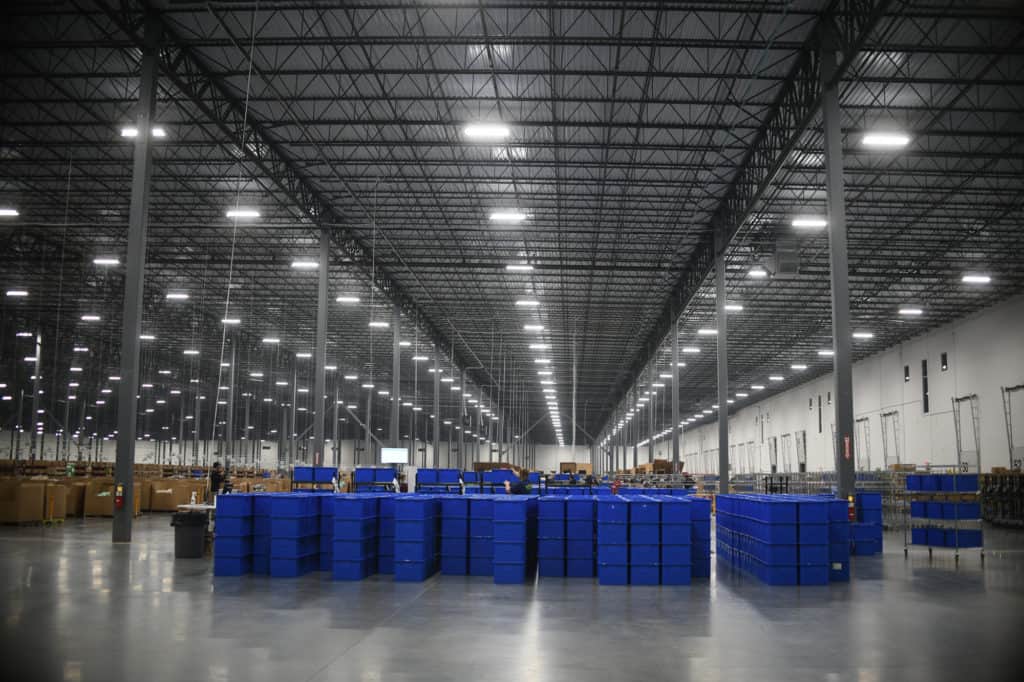The COVID-19 pandemic caused unprecedented global supply chain disruptions, impacting the flow of parts and finished goods around the world. Consumer demand across many product categories experienced a sudden shift, as well, with demand for essential products like food, cough medicine, disposable gloves and toiletries increasing sharply, while demand for non-essentials like clothing and jewelry declined sharply. At the same time, supply chain disruptions resulted in shortages of vital parts and components, and retailers such as grocery stores faced challenges keeping items like toilet paper, hand soap and sanitizer and disinfecting wipes on their shelves.
The disruption caused by COVID-19 is unique in that it impacted supply chains across all industries. “In the past, most disruptions were limited to a single supply chain,” explains Dr. Asoo Vakharia, McClatchy Professor and Director of the Supply Chain Management Center at the Warrington College of Business. “The pandemic, however, is affecting supply chains in the aircraft, automobile, electronic products, hospitality, medical, pharmaceutical, retail, technology, travel, and personal service/support industries.” While the effects on each industry differ, no industry has escaped the impacts of the COVID-19 pandemic.
As many states have started the process of reopening their economies, supply chain managers are faced with rethinking their supply chain networks. Building supply chain resilience isn’t a new goal, but it’s become a primary focus for supply chain leaders in the wake of the pandemic crisis, particularly in the hardest-hit industries, such as food and beverage. Warehouse managers face numerous challenges, as well, such as the need to keep goods flowing in and out of the facility while enabling associates to practice social distancing measures. It’s likely that in the coming months and years, many supply chain leaders will look to automation solutions that help to minimize physical contact and the number of touches required to move products through the supply chain.
As global supply chains start the long process of recovery, supply chain management is in the spotlight, and new best practices and innovative strategies are emerging as supply chain leaders aim to reduce risk in an uncertain future. Below, we’ve highlighted 50 expert supply chain management tips and best practices for navigating the post-pandemic world:
- Mitigating supply chain risks
- Supply chain crisis management
- Supply chain optimization
- Leveraging technology to optimize the supply chain
Mitigating supply chain risks
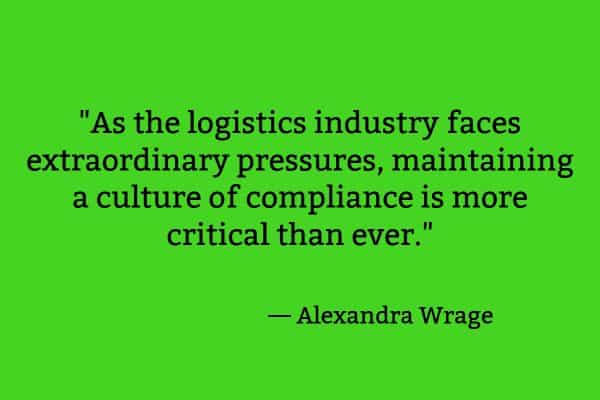
1. Maintain a culture of compliance, even in times of crisis. “As the logistics industry faces extraordinary pressures, maintaining a culture of compliance is more critical than ever. Senior management should set the tone, announcing that anticorruption efforts remain a priority, and ensure the message reaches all employees and partners by mandating training, reinforcing the code of conduct, and reiterating that now is not the time to circumvent the rules — even if doing so would temporarily speed up business processes.
“Additionally, a review of reporting procedures can act as a safeguard against corruption throughout operations. All stakeholders who interact with the supply chain should be aware of hotlines and other reporting mechanisms, which should establish a clear path and adequate protections for whistleblowers.” — Alexandra Wrage, How to Mitigate Supply Chain Corruption During High-Risk Periods, ASCM Insights; Twitter: @ascm_org
2. Build flexible supply networks to minimize the risk of disruption. “When US–China trade tensions flared last year, leading companies already started to rethink the cost of network risk and invest in more resilient supply chains. Flexible networks help companies adjust quickly in times of stress. They also help production teams pivot nimbly to meet changing market demand, a significant competitive edge.
“Bain analysis shows that companies with resilient supply chains grow faster because they can move rapidly to meet customers’ needs when market demand shifts. They increase their perfect order rate by 20% to 40% and customer satisfaction by as much as 30%. Importantly, flexible supply chains cut costs and improve cash flow, in part through a 10% to 40% increase in inventory turns. Finally, leaders reduce disruption by building buffers throughout the supply network and invest in advanced analytics to improve planning and forecasting accuracy.” — Olaf Schatteman, Drew Woodhouse and Joe Terino, Supply Chain Lessons from Covid-19: Time to Refocus on Resilience, Bain & Company; Twitter: @BainAlerts
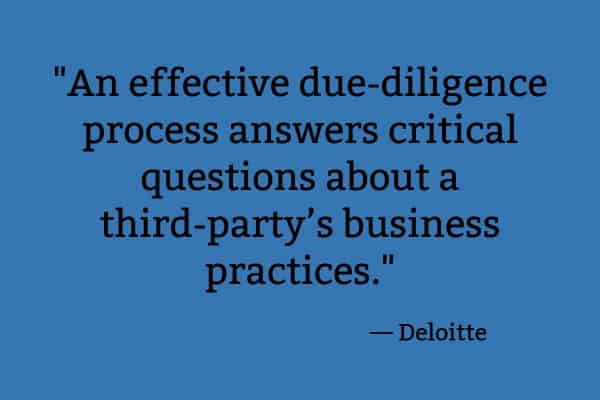
3. Get to know your potential suppliers. “An effective due-diligence process answers critical questions about a third-party’s business practices. For example: Does it have a strong track record for meeting contractual obligations? Do existing business relationships create any conflicts of interest? Does it observe the same high standards as your company with respect to providing safe working conditions and protecting the environment?
“Be sure to consider whether your existing supply network can meet your needs before deciding to bring on a new supplier. Forming strategic partnerships with a select group of your best suppliers can allow you to capture a wide variety of benefits—including the potential for scale advantages and priority service.” — Understanding risk management in the supply chain, Deloitte; Twitter: @DeloitteUS
4. Apply a supply chain stress test. “Our methodology has two central elements. One is time to recover (TTR), the time it would take for a particular node in the supply chain — a supplier facility, a distribution center, or a transportation hub — to be restored to full functionality after a disruption. The second is time to survive (TTS), the maximum duration that the supply chain can match supply with demand after a facility disruption. By quantifying each measure under different scenarios, a business can identify its ability to recover from a disaster. For example, if the TTR for a given facility is greater than the TTS, the supply chain will not be able to match supply with demand unless a backup plan exists. This approach provides companies with a way to financially quantify the cost of disruptions and prepare mitigation plans for the most critical parts of the supply chain that could be applied in different scenarios.” — David Simchi-Levi and Edith Simchi-Levi, We Need a Stress Test for Critical Supply Chains, Harvard Business Review; Twitter: @HarvardBiz
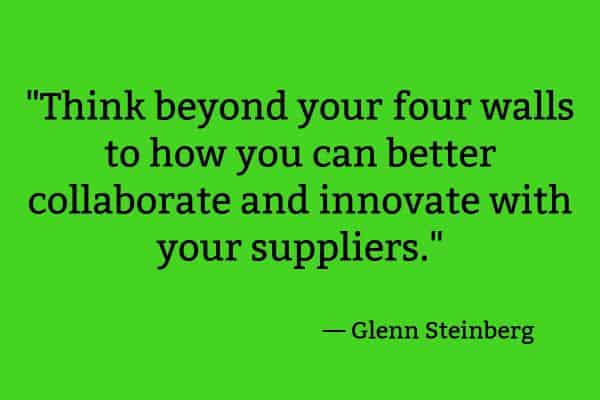
5. Adapt to the next-gen supply chain model. “Think beyond your four walls to how you can better collaborate and innovate with your suppliers. The next-gen supply chain model is a networked ecosystem – suppliers, partners, manufacturers, distributors and retailers will all have access to relevant cloud-based data to make the best decisions based on real-time signals.” — Glenn Steinberg, What do you need to help you build a more resilient supply chain?, EY; Twitter: @EYnews
6. Consider localization. “The U.S.-China trade war has already put regionalization of manufacturing back on the table. While production moves have begun in many cases, localizing the supplier base is also worth considering. When Toyota pioneered lean production in Japan back in the 1970s, its suppliers facilitated this by being colocated nearby. Chinese manufacturers did the same as they evolved their operations during the 1990s and early 2000s. Yet many companies, lulled by efficient and relatively inexpensive logistics and transport, have been applying lean and just-in-time production methods that span global networks. The current crisis exposes the vulnerability of this approach. Notably, Toyota continues to practice localization to a greater extent than many of its competitors. In fact, for its Georgetown, Kentucky, factory, more than 350 suppliers are located in the United States and more than 100 inside the state of Kentucky.” — Willy Shih, Is It Time to Rethink Globalized Supply Chains?, MIT Sloan Management Review; Twitter: @mitsmr
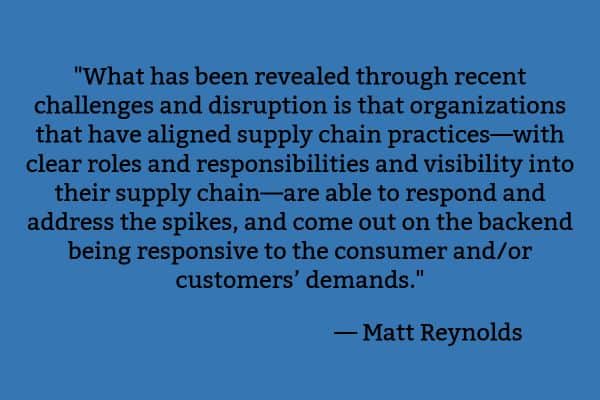
7. Supply chain realignment will help companies prepare for future disruptions. “What has been revealed through recent challenges and disruption is that organizations that have aligned supply chain practices—with clear roles and responsibilities and visibility into their supply chain—are able to respond and address the spikes, and come out on the backend being responsive to the consumer and/or customers’ demands. But it’s not too late for organizations to start planning today for the next iteration. And this is where supply chain professionals, along with sustainability professionals, the sales teams, and new-product development, now need to come together and to evaluate what the market looks like, what downstream impact is going to have on their customers and on their suppliers, and their supplier’s supplier.” — Matt Reynolds, Opinion: As COVID-19 Precipitates Big Consumer Shift, Omnichannel Adapts, Packaging World; Twitter: @packagingworld
8. Automate elements of your supply chain for better data. “Some companies are starting to invest in creating data-backed profiles of their supplier base so they know where and when to look for second sources. Others are increasing communication with suppliers to better understand financial health. For many, conducting deeper financial and health reviews of suppliers will become a regular part of their business reviews. Physical supply chain relocations will likely happen only as a last resort, given the costs involved. However, automation of certain elements of the supply chain — to eliminate time-consuming manual tracking efforts and check tariff structures, for example — will likely become more common as companies seek better data to make more informed decisions.” — PwC’s COVID-19 CFO Pulse Survey, PwC; Twitter: @PwCUS
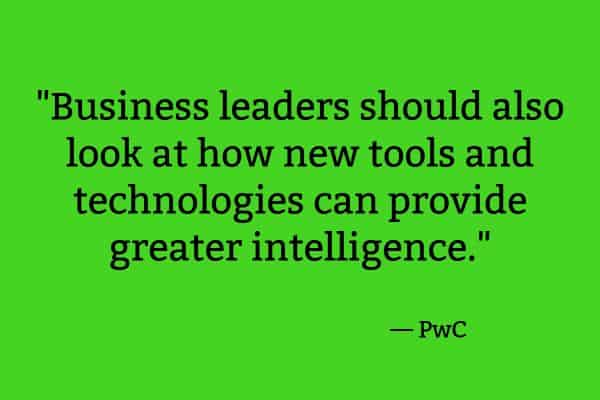
9. Model new risks and costs. “Business leaders should also look at how new tools and technologies can provide greater intelligence. For example, risk evaluation tools that make use of machine learning can find patterns that can indicate risks or opportunities in macroeconomic, geopolitical and global health, exchange rate and other data. In addition, company executives should consider expanding landed-cost tools to include new elements, such as the (potential) cost of carbon offsets. These tools can also rapidly model alternate supply and transportation scenarios, such as rerouting around a port strike or going to an alternate source of supply.” — COVID-19: Operations and supply chain disruption, PwC; Twitter: @PwCUS
10. Develop a clearly defined risk mitigation governance structure. “As companies struggle to cope with the fallout from the COVID-19 crisis and plan for their eventual recovery, one thing is clear: Preparation is key. It is far easier to conduct periodic supply chain analyses according to an established plan than it is to conduct them all at once in the midst of chaos.
“Supply chain resiliency is best supported by a clearly defined risk mitigation governance structure that is aligned to the strategy of the organization. Establishing protocols, metrics, organizational owners, and related processes can empower organizations to respond more effectively when faced with a crisis.” — Michael Varney and Wil G. Knibloe, COVID-19 and the Global Supply Chain, Supply & Demand Chain Executive; Twitter: @SDCExec
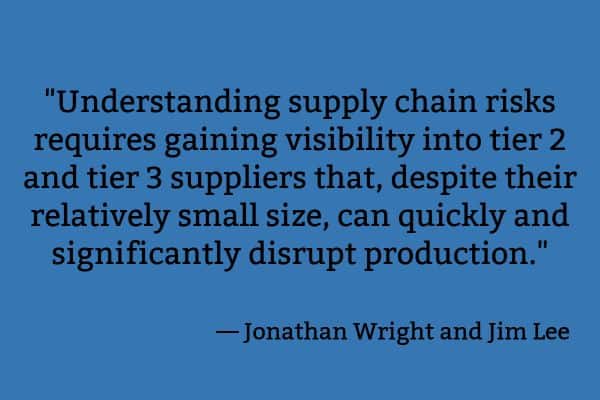
11. Establish a coordinated crisis-support system in collaboration with supply chain partners. “Understanding supply chain risks requires gaining visibility into tier 2 and tier 3 suppliers that, despite their relatively small size, can quickly and significantly disrupt production. The knock-on impacts of China’s shutdowns early in 2020 sparked strong interest in geographical diversification of supply chains. Recent reports show that over 90 percent of the Fortune 1000 companies have tier 2 suppliers in the regions of China most affected in the initial phase of the global COVID-19 pandemic. Any impediment to interaction and engagement with these suppliers makes risks hard to manage.
“At the same time, there’s been a heightened premium on accelerating or driving greater agility into supply chains to better manage rapidly evolving situations. Perhaps the most resilient course of all may be teaming up with supply chain partners to establish a coordinated crisis-support system. In such situations, partners will likely rise or fall together, and sharing information, ideas, and response strategies in that climate becomes highly valuable.” — Jonathan Wright and Jim Lee, COVID-19 and shattered supply chains, IBM; Twitter: @IBMIBV
12. Develop alternative sources and diversify value chains. “Once the initial impacts of the crisis are mitigated, it’s all about foreseeing the next ‘when.’
“For example, supply chain leaders and their teams can conduct a scenario planning exercise and develop action plans. It’s also a good time to discover or develop alternative sources and diversify value chains.
“Tackle strategic and concentrated supplies with high value at risk where internal risk capacities to absorb, such as alternative sources, routes, inventory and cash reserves, aren’t sufficient enough to mitigate any major disruption. Being better prepared than the competition could even open new opportunities when the next disruption comes around.
“It is not about analyzing ‘if’ a disruption will happen but about establishing action plans and being able to deploy rapidly ‘when’ disaster strikes.” — Koray Köse, Mitigating Impact of the Coronavirus on Supply Chain, Supply Chain Management Review; Twitter: @SCMR

13. Implement supply chain traceability for assurance. “Many companies are eager to publish their supply chains once they’re mapped. Your legal department will ask for more: that’s because supply chain mapping is only based on supplier disclosure. Supply chain traceability is the process of tracking every commercial transaction in the end-to-end supply chain to account for the time and place where every step occurred in the supply chain of a unit, batch or lot of finished goods. Traceability offers a number of advantages, from real-time chain of custody reports to verification that products are authentic and vendors are certified. It’s also becoming law, from pharmaceutical serialization to US FDA food safety.” — Leonardo Bonanni, What is the difference between supply chain mapping, traceability and transparency?, Sourcemap; Twitter: @sourcemap
14. Don’t let monitoring slide for long-term supplier relationships. “Watch your SLAs and KPIs like a hawk. Now is the perfect time to take a look at your supplier’s obligations and make sure they’re living up to them. If you haven’t developed any KPIs or monitoring processes, start thinking through what measures define success or failure, and how Procurement can go about confirming a supplier stays on track.
“Stay rigid with scheduled check-ins. It is common for quarterly reviews to get pushed back, shortened, or skipped altogether years into these long relationships. Don’t let it happen. Likewise, stick to the agenda even if it feels ‘done to death’ over the years: These meetings are to reconcile today’s performance, not recounting the good years of the past.” — Brian Seipel, Leveraging Strategic Supplier Relationships, Source One Strategic Sourceror; Twitter: @GetSavings
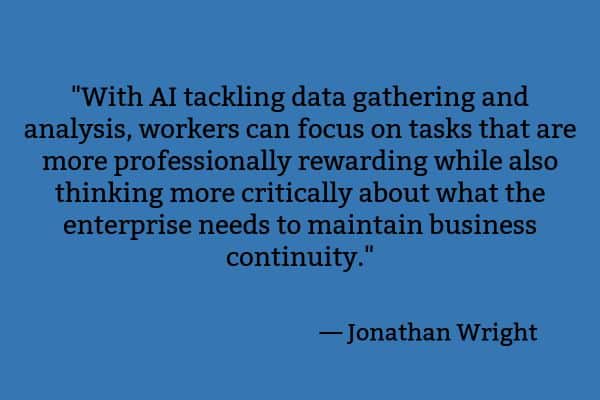
15. Realign your business to respond faster to changing demand signals. “With AI tackling data gathering and analysis, workers can focus on tasks that are more professionally rewarding while also thinking more critically about what the enterprise needs to maintain business continuity. Organizations should also consider better risk management of supply chains enabled by hybrid cloud and analysis of external data, allowing for more careful planning and less reactive decision-making. Finally, they should start to integrate teams around intelligent workflows, helping to realign the business so it’s able to respond quicker to rapidly changing demand signals.” — Jonathan Wright, as quoted by Patrick Burnson in New IBM Report Explains How to Leverage Technology to Counter Pandemic Disruption, Supply Chain Management Review; Twitter: @SCMR
16. Aim for a real-time reach across all tiers in your supply chain network. “What’s needed goes well beyond a basic ecommerce platform. It includes a complete supply chain solution with integrated multi-tier inventory optimization, order brokering, merge, and cross-docking, including last-mile delivery, and the ability to create an allocated Available-to-Promise (ATP) for order promising to a delivery window in a home within a few hours. And all this needs to be optimized on cost.
“A tall order? Perhaps not. Today’s network platforms make it possible, and in this way, you’ll enable your whole ecosystem to capitalize on the shift toward direct-to-consumer and achieve a fast ramp in consumer-driven last-mile deliveries. And you’ll be fully prepared as economies recover.” — Joe Bellini, Demand-Driven Logistics: Consumer Direct and the Last Mile, Supply Chain 247; Twitter: @SupplyChain247
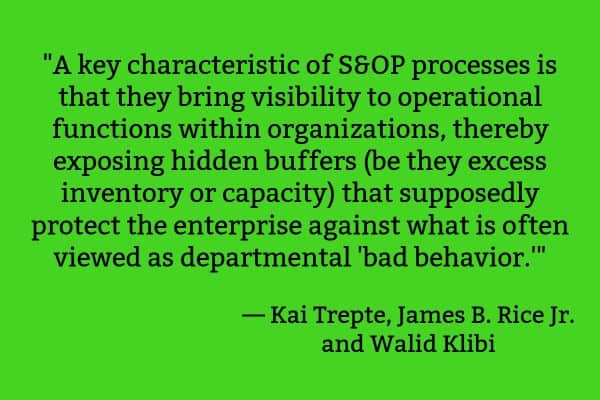
17. Develop a resilient sales and operations planning (S&OP) process. “A key characteristic of S&OP processes is that they bring visibility to operational functions within organizations, thereby exposing hidden buffers (be they excess inventory or capacity) that supposedly protect the enterprise against what is often viewed as departmental ‘bad behavior.’ Examples of such bad behavior include sales representatives inflating their forecasts to ensure adequate supply, or operations maintaining extra inventory to account for low forecast accuracy. When an organization implements S&OP, these hidden buffers become visible because each stage of the S&OP process seeks to remove unplanned slack and improve efficiency by causing inflated forecasts to shrink and inventory caches to disappear.
“While such benefits are laudable, they do present a significant downside: The efficiency-building measures promoted by S&OP can produce business plans that can be quite rigid, making it hard for organizations to respond to unexpected disruptions. Consequently, when a resilience-based approach is not integrated into S&OP, the strengths that distinguish the process can become liabilities.” — Kai Trepte, James B. Rice Jr. and Walid Klibi, S&OP: A new frontier for supply chain resilience?, Supply Chain Quarterly; Twitter: @TheQuarterly
18. Ensure your supply chain continuity plans address remote business operations. “During the present pandemic, remote business operations have proven to be paramount. Supplier-partners should be virtualized and have remote work plans and policies in place, be able to explain how they will deploy employees outside of plant locations, and clarify how quickly they can implement these work processes. All personnel should be able to connect remotely to the systems necessary for them to carry out their job responsibilities. Suppliers should be able to detail the technologies they have installed to enable these connections, including ensuring that employees have laptops or other necessary devices, and their plans for supporting higher-than-usual demands on bandwidth.” — Roger Shaw, 9 Essential Elements of Supply Chain Continuity Planning, ASCM; Twitter: @ascm_org
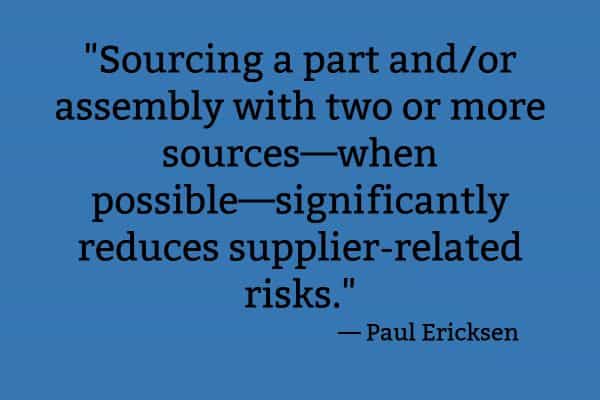
19. Consider a dual-supplier sourcing strategy. “Sourcing a part and/or assembly with two or more sources—when possible—significantly reduces supplier-related risks. This arrangement typically takes the form of one local supplier—which provides order fulfillment assurance—and one from overseas, which helps reduce overall material cost.
“Of course, this strategy can require additional investment when tooling is required. It can also require more oversight from the supply management function. But these additional costs are usually more than covered when risks that are associated with overseas sole sourcing are reduced or eliminated.
“Personally, I believe that a dual-supplier sourcing strategy represents a best case middle-ground approach and should be considered, especially when demand forecasts are open to significant error.” — Paul Ericksen, Supply-Chain Risk Planning: What’s the Best Approach?, IndustryWeek; Twitter: @IndustryWeek
20. Rethink safety stocks. “The traditional view is that inventory should be treated like calories: we need a certain amount each day to function, and things tend to go south when there is excess. But have we taken too radical a view when it comes to inventory levels?
“Trying to ‘lean out’ our supply chains has been the mantra for ages. We strive to reduce working capital. Safety stock is ‘bad.’ Do we need to reassess this? Look for certain supply chains – think medical devices, pharmaceuticals – to rethink how they view safety stocks. This will push financial institutions to reconsider how they measure the financial health of these businesses.” — Guy Courtin, Opinion: A Post-Covid 19 World for Supply Chains: Back to the Future?, 6 River Systems; Twitter: @6riversystems
Supply chain crisis management
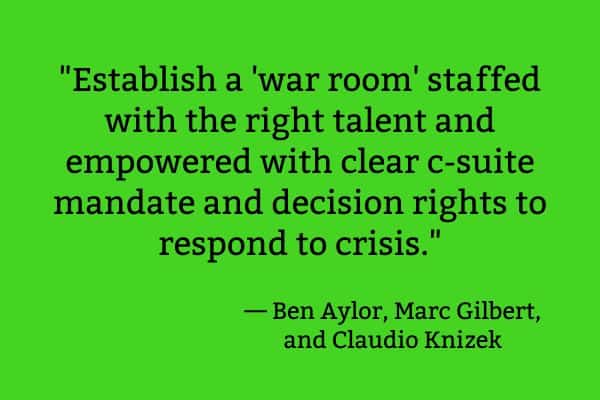
21. When a crisis hits, establish a war room to oversee your company’s response. “Establish a ‘war room’ staffed with the right talent and empowered with clear c-suite mandate and decision rights to respond to crisis. This team will drive required actions while monitoring the evolving risks daily. In addition, be sure the team balances a quick response with a long-term sustainable approach.” — Ben Aylor, Marc Gilbert, and Claudio Knizek, Responding to the Coronavirus’s Impact on Supply Chains, LinkedIn; Twitter: @BCG
22. Prioritize discovery to obtain a full picture rapidly. “Develop a high risk for supply chain disruption monitoring and response programs for countries impacted by the virus and potential supply chain exposure from tier 1 and below. If lower tier transparency is missing, start building up the program and prioritize discovery to get a full picture rapidly. It’s also important to assess how customer spending might be affected.
“The next step is to make sure all inventory is within reach and outside impacted areas and logistical hubs. Additionally, supply chain leaders should work with their legal and HR departments to understand any financial implications of not being able to deliver supply to customers and provide guidance to employees located in the impacted areas.” — Sarah Hippold, Coronavirus: How to Secure Your Supply Chain, Gartner; Twitter: @Gartner_inc

23. Ask new third-party partners to outline their contingency plans to evaluate preparedness. “Many supplier screening programs were devised for a differing level of risk. As the context has now changed, so too must the program. After shortlisting suitable alternatives, ensure that context-heavy, proportionate and risk-based screening is carried out to identify the legal, reputational or financial risks they may bring with them. Ask new third parties to outline their own COVID-19 contingency plan to see how well-prepared they are to face the pandemic and the knock-on effects. This approach will help to streamline workflows when looking at a high volume of entities.” — John Wilkinson, COVID-19: Four key steps for managing integrity risk in supply chains, EY; Twitter: @EYnews
24. Consider appointing or hiring a COVID-19 intelligence agent. “Another best practice we see is the emerging role of the COVID-19 intelligence agent. CSCOs are transitioning their most experienced demand planners away from traditional planning operations and into this new role. This enables them to focus on gathering key indicators and insights to better inform assumptions and scenario planning. Sometimes, this role also includes managing the recovery scorecard.
“A recovery scorecard is a great way to determine when operations can start to establish a new business-as-usual approach. For example, a consumer products business might determine that it will reestablish its demand plan once 90% of field agents — employees who work closely with retail customers — have returned to work and provide localized forecasts. Other indicators that might be included in the recovery scorecard are the growth rate of COVID-19 cases, consumer spending, supplier material availability or factory output.” — Tina Hu, 2 Best Practices for Rebooting the Supply Chain, Gartner; Twitter: @Gartner_inc
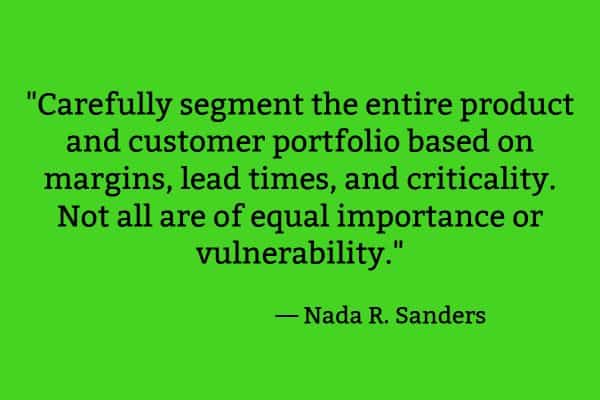
25. Segment your product and customer portfolio to identify priorities. “Carefully segment the entire product and customer portfolio based on margins, lead times, and criticality. Not all are of equal importance or vulnerability. Create a matrix based on these two dimensions identifying customers, products, and sources of supply that are most critical and most vulnerable within each quadrant. Set priorities. Which customers get served first? Which suppliers are critical? Which components have the longest lead times?” — Nada R. Sanders, Bracing for the Coronavirus Downturn: 6 Steps to Take Now, IndustryWeek; Twitter: @IndustryWeek
26. Direct supplies to the highest-margin products and customers. “During several disruptions to microelectronics supplies over the past 25 years, the largest PC makers, including HP, Dell, and Apple, were high on suppliers’ priority lists. Differentiated allocation policies favor some customers while impeding others.
“A related allocation criterion is to direct supplies to the highest-margin products and customers. For example, General Motors scrambled to find scarce materials in 2011 after a trifecta of disasters — an earthquake, a tsunami, and a nuclear meltdown — hit Japan and devastated factories there. In GM’s crisis room, ‘Project J’ had supply chain professionals scouring the globe to find sufficient parts to keep all of the company’s car factories running. Despite the frantic search, at one point GM could not find enough airflow sensors for its trucks. The team decided to prioritize full-sized trucks over small trucks because the larger vehicles were both more profitable and had smaller retail inventories.” — Yossi Sheffi, Who Gets What When Supply Chains Are Disrupted?, MIT Sloan Management Review; Twitter: @mitsmr
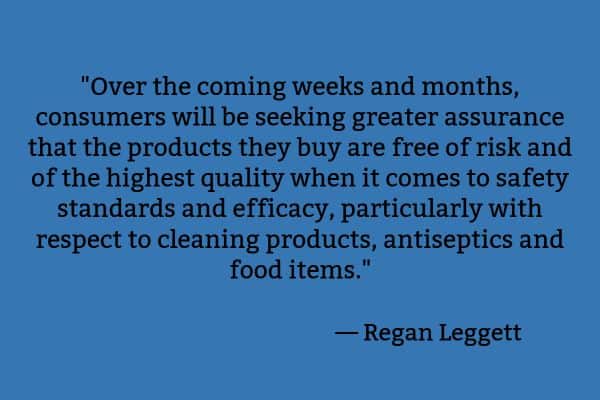
27. Emphasize quality and efficacy. “With all the learnings, opinions and behavior evolving before our eyes, one factor can be safely assumed: Over the coming weeks and months, consumers will be seeking greater assurance that the products they buy are free of risk and of the highest quality when it comes to safety standards and efficacy, particularly with respect to cleaning products, antiseptics and food items.
“In the short term, this intensified demand from consumers will require manufacturers, retailers and other related industry players to clearly communicate why their products and supply chains should be trusted. In the longer term, and dependent on the eventual scale and impact that COVID-19 has on consumer markets, it may speed up a re-think on how shoppers evaluate purchases and the benefits that they see as the key factors to consider.” — Regan Leggett, Quality and Efficacy May Beat Out Price Sensitivities Amid Coronavirus Concerns, Nielsen; Twitter: @Nielsen
28. Take the opportunity during shutdowns to identify and eliminate bottlenecks and update system data. “Systems will have to fully support operations restart plan implementations and will require adaptability to adjust to the crisis development. The lockdown period should be used to remove traditional burden and complexities such as:
- anticipate bottlenecks and reallocate resources to mitigate/remove them;
- simplify system entries and processes whenever needed especially in WMS & TMS systems;
- re-parameter systems to fully leverage touchless operation like MRP;
- automate processes and basic transactions to ensure systems can operate with limited resources; and
- adapt system profiles and rights to ensure more flexibility.
“A significant amount of work is also going to be needed on system data update, especially carrier and inventory data, to ensure the right information is used to make decisions.” — Emmanuel Hassoun and Pierre Mawet, How to restart operations after coronavirus shock: A logistics perspective, Modern Materials Handling; Twitter: @modernmhmag
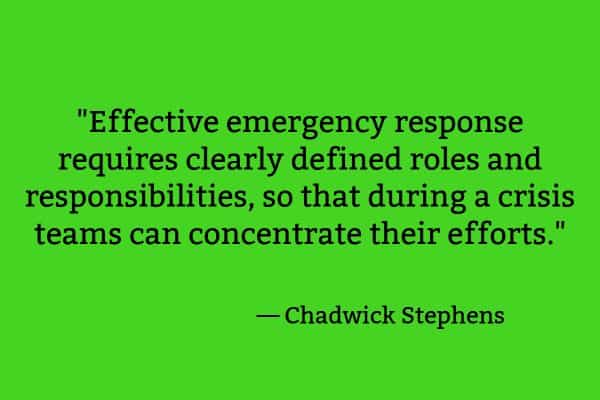
29. Dedicate tasks and decisions to the most qualified team members. “Effective emergency response requires clearly defined roles and responsibilities, so that during a crisis teams can concentrate their efforts. As requests and inquiries come in, and information is essential, team members need to know who to go to for answers. Writing in Harvard Business Review, Eric McNulty warns against micromanaging and over-centralizing decision making. Delegation of tasks and decisions to those who are best equipped to make them will keep your office’s response efficient and flexible. This allows team members to play to their strengths and allows the chief official to focus on the big picture and the next steps in the response.” — Chadwick Stephens, 5 Ways to Improve Your Procurement Crisis Management, Procurement Pulse by NASPO; Twitter: @NASPOnews
30. Plan for a bull-whip effect in the aftermath of COVID-19. “In the medium term, companies should plan for a bull-whip effect to impact their business and their suppliers due to high volatility. Link supply to the consumer demand within the business and allow trusted suppliers to have full visibility of demand. On a broader scale, AI/ML-based demand planning tools using big data and hot data sets should be leveraged to aggregate metrics like weather and seasonal shopping habits that allow for stronger predictive models in preparation for the ramp of demand during the path to normalcy.” — Hilding Anderson, COVID-19: Preparing Your Supply Chain in Times of Crisis, Publicis Sapient; Twitter: @PublicisSapient
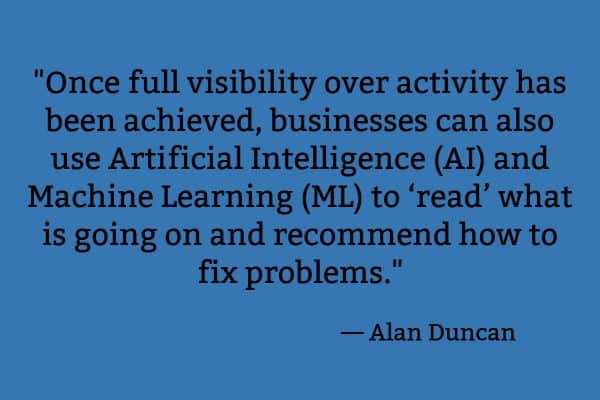
31. Establish a control tower leveraging AI and machine learning to respond in real-time. “Supply chain management technology can also play a crucial role; if businesses cannot keep track of everything that is happening, how can they even begin to react when they hit disruption? This is where control towers can be deployed to give visibility over all activity, offering a visual representation that makes it possible to fully comprehend the status of all moving parts. This viewpoint makes it a more realistic prospect to identify problems as they are beginning to unfold, and to figure out how to resolve them.
“Once full visibility over activity has been achieved, businesses can also use Artificial Intelligence (AI) and Machine Learning (ML) to ‘read’ what is going on and recommend how to fix problems. In time, AI/ML systems could even put those changes into place without input from humans, to form an autonomous supply chain. AI can also start to predict disruptions and then, autonomously prevent or avoid them.” — Alan Duncan, Add some muscle: How to avoid being hamstrung by your supply chain the next time a crisis hits, Supply Chain Digital; Twitter: @SupplyChainD
Supply chain optimization
32. Take a holistic approach to supply chain management. “Through the expansion of more comprehensive software and holistic management practices, improved supply chain management techniques have become a smart, yet still under-utilized tool for today’s most savvy executives.
“Excellent supply chain strategies provide ways to move ahead of the competition in an increasingly complex marketplace. To achieve supply chain excellence, organization leaders need to pay particular attention to the details of their infrastructure. Viewed collectively, these details can support a more efficient and effective supply chain management process that can promote more aggressive performance goals across such areas as purchasing, general operations, distribution, and integration strategies.” — Understanding Supply Chain Excellence, Michigan State University; Twitter: @michiganstateu
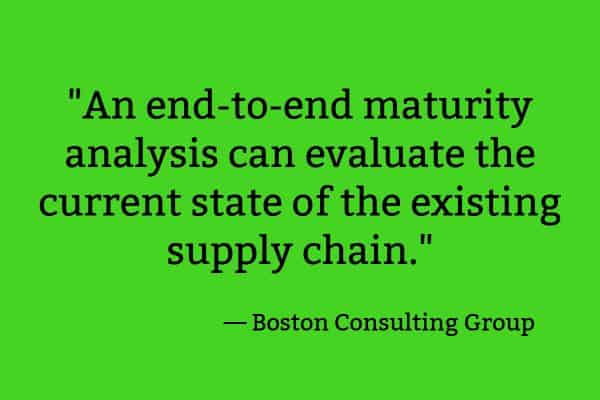
33. Conduct an end-to-end maturity analysis to evaluate the health of your supply chain. “An end-to-end maturity analysis can evaluate the current state of the existing supply chain. The health check includes a survey of customer expectations, an audit of stakeholder beliefs, and interviews with business executives to gauge their commitment to improvement. The results help businesses identify benchmarks and key trends, and understand the opportunity for supply chain optimization.” — Customer-Centric Supply Chain Transformation, Boston Consulting Group; Twitter: @BCG
34. Determine where your organization falls on the transparency continuum. “Transparency can be measured along two dimensions: supply chain scope (the depth of interaction in the supply chain) and milestones on the path to complete transparency. Based on our learnings over the last decade, we have applied part of the innovation diffusion theory, a concept originally posed by Everett Rogers that outlines how an innovation spreads and is adopted, to map the progress of firms moving towards supply chain transparency.
“Most companies are either at the Majority stage, where they have proper oversight over their facilities, or occupy the Early Majority stage, where they audit and monitor direct suppliers for compliance. Fewer companies can be considered Early Adopters that engage with indirect suppliers (suppliers beyond their direct suppliers) and trace individual transactions. Only Innovators are ready to share information about raw materials suppliers.” — Alexis Bateman and Leonardo Bonanni, What Supply Chain Transparency Really Means, Harvard Business Review; Twitter: @HarvardBiz
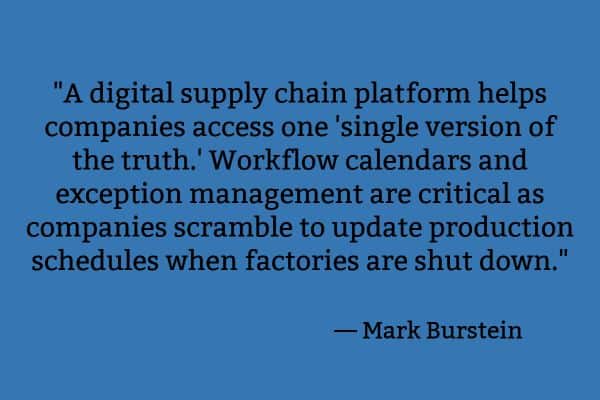
35. Improve transparency and visibility with a single source of truth. “When planning, sourcing, design production, and logistics are part of one connected enterprise system, retailers can thoroughly assess problems to mitigate damage.
“Collaborate globally. A digital supply chain platform helps companies access one ‘single version of the truth.’ Workflow calendars and exception management are critical as companies scramble to update production schedules when factories are shut down.” — Mark Burstein, COVID-19 Supply Chain Resources & Strategies, Inbound Logistics; Twitter: @ILMagazine
36. Leverage supply chain mapping. “Yes, supply network mapping can be resource intensive and difficult. However, there is no way around it. Companies will discover the value of the map is greater than the cost and time to develop it.
“The most common approach is to use the bill of materials and focus on key components. It typically starts with the top five products by revenue and goes down to their component suppliers, and their suppliers, ideally, all the way down to raw materials suppliers. The goal should be to go down as many tiers as possible, because there may be hidden critical suppliers the buying firm is not aware of. The map should also include information about which activities a primary site performs, the alternate sites the supplier has that could perform the same activity, and how long it would take the supplier to begin shipping from the alternate site.” — Thomas Y. Choi , Dale Rogers and Bindiya Vakil, Coronavirus Is a Wake-Up Call for Supply Chain Management, Harvard Business Review; Twitter: @HarvardBiz
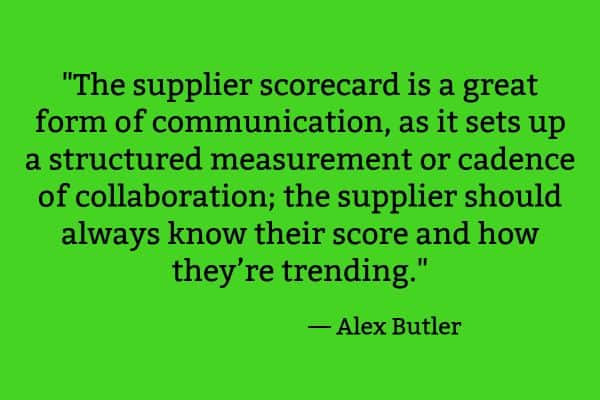
37. Implement supplier scorecards. “When manufacturer-supplier relationships aren’t built on communication, collaboration and transparency, risks to quality grow greater in likelihood and consequence – even in the best of times. With the added layer of complexity and urgency in the supply chain due to large-scale disruptions like a global pandemic, manufacturers must forge stronger partnerships with their suppliers.
“Direct, honest communication between a manufacturer and supplier helps deliver quick changes to the product and needs. As part of establishing two-way communication, it is important to identify responsibilities and define expectations for each party. This should help build accountability, accelerate response times and streamline the entire sourcing process. The supplier scorecard is a great form of communication, as it sets up a structured measurement or cadence of collaboration; the supplier should always know their score and how they’re trending.” — Alex Butler, Supplier Quality Problems During a Global Pandemic, Industrial Distribution; Twitter: @InDistwebsite
38. When something’s not working, embrace innovation. “The risk of change goes way down in a crisis. If something’s not working today, there is little risk in trying something new. Many of the marketplace changes we’re experiencing now – the continued migration to e-commerce, the growth of new delivery services and working from home, to name a few – will probably remain with us. Think of ways your business can benefit from the changed environment. Speed company decision-making and try out something new to meet the changing circumstances. To paraphrase Rahm Emanuel, don’t let a serious crisis go to waste. It’s an opportunity to do things that you never thought possible.” — Lauren Pittelli, Moving from Just in Time to Just in Case, IndustryWeek; Twitter: @IndustryWeek

39. Use SLAs (service level agreements) to create a feedback loop. “It’s proven that being a data-driven company provides unique advantages. But it’s hard to be data-driven without good data!
“SLAs become an excellent way to collect data that can be a feedback loop into decision making processes. Beyond the benefits [of] driving clarity and agreement, a partner providing data to support an SLA is a legal requirement of the contract. It’s an unavoidable window into transparency with the partner.” — Jason Murray, How Service Level Agreements (SLAs) Can Propel Your Supply Chain, SCM Dojo; Twitter: @muddassarisim
40. Always stay up-to-date on regulations and standards and be prepared to prove you’re meeting compliance. “There is no doubt that supply chain transparency is very important and becoming more so every year. Consumers care about where their products come from and how they arrive. Customers want confidence, knowing that they aren’t contributing to the many negative global issues that plague the earth and her citizens.
“They are placing more and more value on responsible sourcing and will go out of their way to become fierce brand loyalists when they know their money is solving problems, not causing them.
“Additionally, a bevy of new laws, regulations, standards, and guidelines are put in place regularly to help stymie issues that crop up all along the chain of supply. Your company must be up to date on them and able to provide documentation to prove you are following protocol. Otherwise, you could be in a world of reputational hurt and flooded with fines and fees.” — What Are the Benefits of Supply Chain Transparency?, Avetta; Twitter: @AvettaNews For even more, check out our article on “The Benefits of Supply Chain Management.”
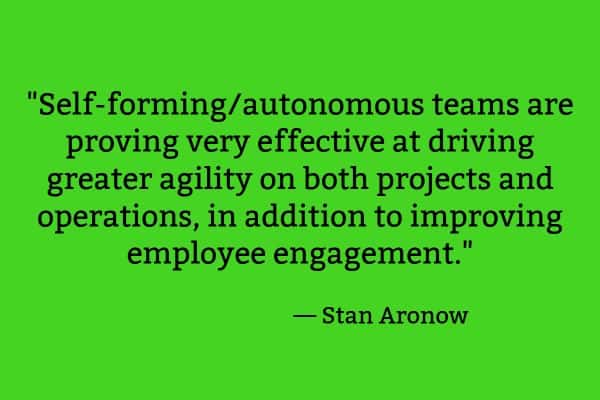
41. Leverage self-forming/autonomous teams to drive agility. “Self-forming/autonomous teams are proving very effective at driving greater agility on both projects and operations, in addition to improving employee engagement. New skills such as facilitation and storytelling are required of team members. Members of these teams have demonstrated extremely impressive agility, an ability to work under pressure, self-motivation and higher overall job satisfaction.” — Stan Aronow, Next Generation Agility: An Antidote to Uncertainty, SCM World; Twitter: @SCM_World
Leveraging technology to optimize the supply chain
42. Conduct an end-to-end review to find areas where technology can improve processes. “We all know that manually driven processes are a huge reason for a lack of visibility along the supply chain. This is especially true of global companies.
“You must review end-to-end to find areas where technology can improve the process (rather than first buying into a specific software package and finding where it can fit). Then, go a step further and use technology to gain data and detailed reporting. This will better inform the supply chain council on how to improve performance and plan strategically. Ensure each automation is well-managed and maintained throughout the cycle.
“An oft ill-tapped resource is your company’s own IT department. They are professionals who keep up on all the latest tech and have a solid understanding on what can actually work well for your particular supply chain. Involve them in discussions and heed their tech advice.” — Your Guide for Effective Supply Chain Improvement Projects, Avetta; Twitter: @AvettaNews
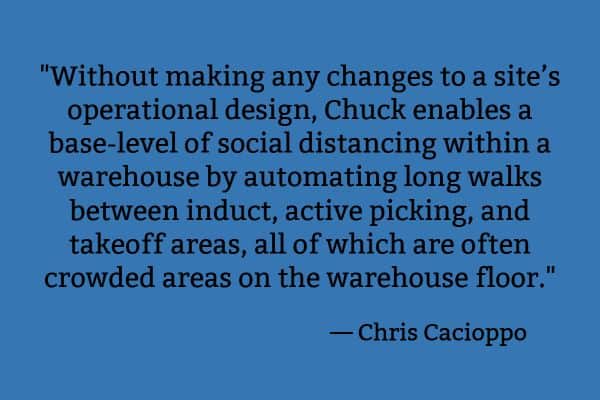
43. Adopt innovative technology that allows for social distancing. “When mitigating risk of exposure to pathogens, there are two schools of thought that we are recommending to our customers: sites should seek to minimize tactile exposure throughout the warehouse and maximize social distance between associates. Regardless of the approach decided upon by the customer, 6RS is a directed system with associates simply following instructions from Chuck.
“Without making any changes to a site’s operational design, Chuck enables a base-level of social distancing within a warehouse by automating long walks between induct, active picking, and takeoff areas, all of which are often crowded areas on the warehouse floor. With the exception of breaks, the associate can remain on the picking floor at a safe distance from other associates.” — Chris Cacioppo, How 6 River Systems solutions protect warehouse associates during the COVID-19 crisis, 6 River Systems; Twitter: @6riversystems
44. Leverage and master your supply chain data. “Bottlenecks in supply chain processes directly affect the agility of your operations and eventually adversely affect supply chain resilience. Inefficient supply chain master data management (e.g., material, price, logistics, vendor, and customer) will disrupt your operations, create stock outs, and tie up valuable resources. However, with the right blend of cost-effective resources coupled with intelligent automation solutions, master data management can be handled seamlessly to optimize your operations across all major supply chain disciplines.” — Jörg Junghanns, How to create sustainable resilience across the supply chain, Capgemini; Twitter: @Capgemini
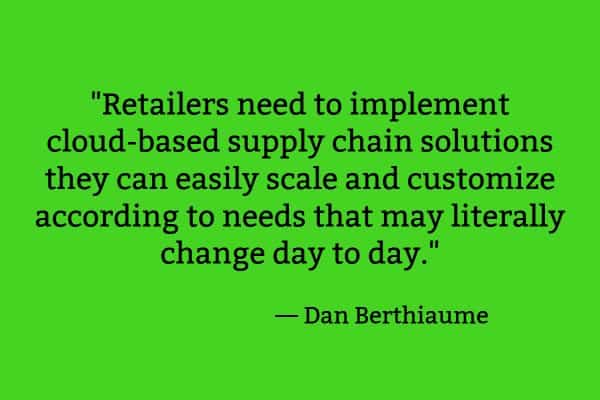
45. Implement cloud-based supply chain solutions. “In the current unpredictable environment, retailers must be able to responsively pivot their supply chains in close to real time as events require. If a damaged location can no longer serve as a ‘dark store’ to support local delivery, retailers need to be able to accurately track needed products at other nearby stores and warehouses. Stores may have to quickly be stood up for curbside and BOPIS depending on shifting COVID-19 guidelines.
“Retailers need to implement cloud-based supply chain solutions they can easily scale and customize according to needs that may literally change day to day. Artificial intelligence (AI) and machine learning (ML) capabilities help ensure supply chains can react with maximum efficiency to situations that simply cannot be predicted. Technologies such as computer vision and RFID enable the item-level inventory transparency that is necessary to achieve normalcy in [a] decidedly abnormal social and business environment.” — Dan Berthiaume, Surviving the ‘new abnormal’ with leading-edge technology, Chain Store Age; Twitter: @ChainStoreAge
46. Extend supply chain visibility beyond your primary suppliers. “Supply chain professionals have long understood the value of seeing beyond the tier-one suppliers into the web or network of suppliers that feed them through their primaries. This may require investment into additional human resources or knowledge as well as possible investment into some technologies that specialize in supply chain management.
“You really need to be able to visualize inbound parts and supplies from raw material all the way through to finished deliverable parts, assemblies or supplies. This will require the collection of localized information and data related to individual suppliers, market forces and other drivers that can affect the availability and scheduling of product delivery further down the chain. This will likely require some sophisticated analytical capability and dedicated headcount.” — Lou Washington, Supply Chain Management During the COVID-19 New Normal, Cincom; Twitter: @Cincom
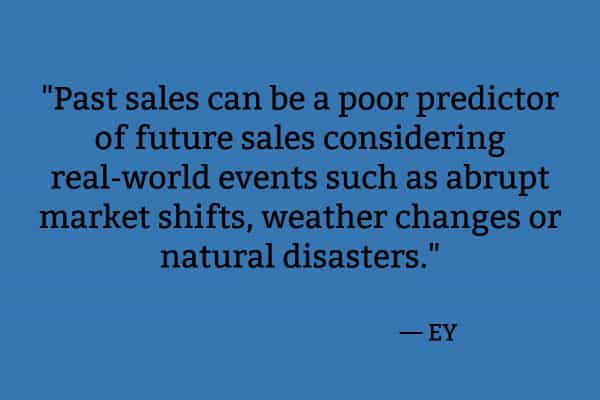
47. Implement technologies such as IoT to increase the visibility of channel inventory. “In the value chain planning domain, traditional demand forecasting relies on time series techniques which create a forecast based on prior sales history. However, past sales can be a poor predictor of future sales considering real-world events such as abrupt market shifts, weather changes or natural disasters. One of the leading global beverage companies has adopted Internet of things (IoT) and visual recognition technology to sense demand in coolers installed in convenience stores, restaurants and supermarkets. With such technologies in place, the company can increase visibility of channel inventory and better respond to an event like the coronavirus outbreak even if distributors cannot provide [a] current-state forecast.” — COVID-19: how to build supply chains resilient to disruption, EY; Twitter: @EYnews
48. Invest in technologies that enable auto-populated data to streamline workflows and reduce corruption. “Improved collaboration efforts through auto-populated data further streamline workflows and reduce the risk of errors when entering and sharing data. Take the average shipment. A single device could be physically touched dozens of times in shipping, and with each touchpoint, systems of record may require more information. Every data entry becomes a possible source of corruption. However, digitized collaborative resources that auto-populate and share data eliminate this risk. And, those same benefits can be scaled to allow for digital document management capabilities too. Remember that physical document management is responsible for 15% of total logistics costs, so any improvement that eliminates the costs of managing physical documents will effectively pay for itself. Any other gains are icing on the proverbial cake.” — Adam Robinson, Commentary: How digital transformation builds supply chain resilience, Freight Waves; Twitter: @FreightWaves
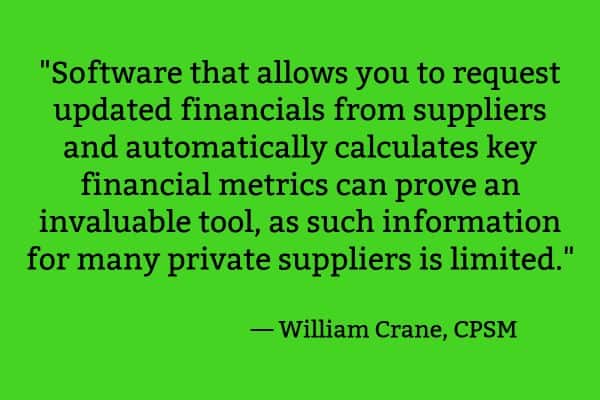
49. Use software to monitor strategic supplier financials. “Now more than ever, it is critical to request and more frequently monitor strategic supplier financials. Steep contractions and rapid increases in supplier sales strain cash flows, working capital and bank loans.
“Actions: Software that allows you to request updated financials from suppliers and automatically calculates key financial metrics can prove an invaluable tool, as such information for many private suppliers is limited. Understand key supplier financial metrics like the Z score bankruptcy-predictor model and available credit lines to gain a better supplier health report.” — William Crane, CPSM, Heeding Early Supplier Warning Signs Can Help Avoid Disruption, Inside Supply Management Weekly; Twitter: @ism
50. Leverage AI to conduct scenario planning. “Organizations must act with imperative when developing and implementing enhanced risk management practices, focusing on the opportunities scenario planning offers in creating pre-emptive action plans. Scenarios enable organizations to see the bigger picture and make effective trade-off decisions on issues like: how much stock to hold – and where, or how to balance the cost of inventory versus the cost of failing to satisfy customers. Simulations can be run swiftly to identify ‘sweet spots’ between apparently conflicting objectives, based on real-time inventory data, customer demand, and supplier capability. Increasingly enabled by AI and automation, these scenarios [can] help prescribe rather than just predict. By analyzing past events and hypothesizing future threats, organizations are able to identify strategic and concentrated supplies that are at risk, and most importantly, recognize when current internal risk capacities prove insufficient.” — Beyond this challenge: What the coronavirus response teaches us, KPMG; Twitter: @KPMG
Interested in more? Let’s discuss the solution that’s right for you. Contact us today.

